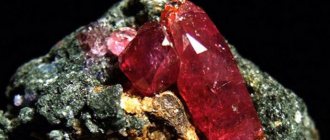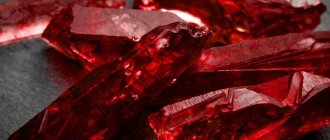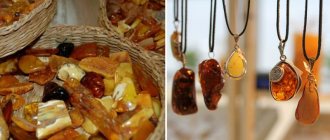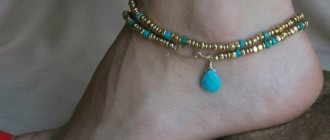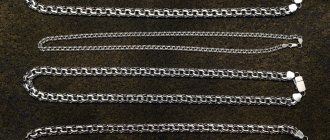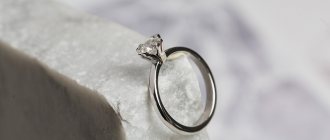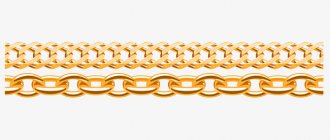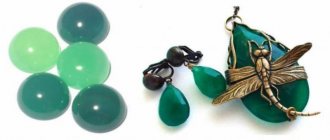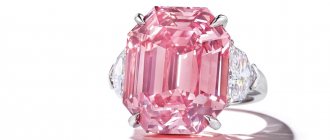Color assessment.
A ruby with an intense red hue is more valuable than less vibrant stones.
Color is the most important quality characteristic of a ruby. Color includes hue, hue and saturation.
- Hue.
The main shade of a ruby should be red. However, there are stones with orange and purple hues. There are also secondary shades that either emphasize the main color or spoil it. However, the choice of shade depends on the tastes of a particular person.
- Tone.
This parameter characterizes how light or dark the ruby is. The most valuable are the average tones. Too dark or light colors will detract from the visual effect of the stone.
- Saturation.
It determines the intensity of the shade. The brighter and more saturated the color, the more valued the ruby is.
Ruby processing options
Gem enhancement is carried out in several ways:
- heat treatment is necessary to eliminate purple and orange tints, as well as to remove rutile microfibers to improve the visual perception of the jewelry;
- the use of a flux medium makes it possible to “heal” open cracks;
- the use of diffuse processing using a beryllium layer allows you to give the ruby a rich red color;
- filling large cracks with a special glass composition improves color and clarity, but reduces the cost of the gem;
- surface coloring is necessary to change the color characteristics (rarely used in jewelry).
All varieties of ruby are subjected to heat treatment and cutting. Only after processing can the gem be set in gold rings, necklaces, chokers and other jewelry.
Purity.
The fewer inclusions a ruby has and the less noticeable they are, the better the quality. It is best to choose rubies with defects that are invisible to the eye and only visible when magnified.
There are stones called “star rubies”, whose defects and inclusions decorate and give a special uniqueness to the stone.
Such rubies are polished like cabochons, which allows them to reflect the incident light in the form of a star with six rays. This is caused by the optical effect that the spider-web-like inclusions give.
Horoscope and magic
The mineral has a fiery nature, so it is perfect for Fire signs (Aries, Sagittarius, Leo). With its help, signs rationally use the qualities given to them at birth: perseverance, determination, firmness, decisiveness, confidence, leadership inclinations. But there are no people consisting of only positive qualities. Fire signs are impulsive, self-centered and have difficulty reading the emotions of people around them. Ruby helps smooth out sharp conflict angles and also improves interpersonal understanding.
Magicians and esotericists believe in the great power of the fire stone. They believe that it is able to kindle feelings between people and increase attractiveness in the eyes of the opposite sex. Besides this he:
- Strengthens the willpower of a person, makes him stronger and more resistant to difficulties.
- Stimulates physical and mental activity.
- Protects the owner from external negativity (anger, envy, aggression, slander).
Cut.
Cut is a fairly significant characteristic of a ruby. Firstly, it is designed to improve its shape and appearance. Secondly, the proportions and symmetry of the cut determine the stone's ability to reflect and refract light, creating brilliance and sparkle. Thirdly, the cut should ensure the durability of the stone by protecting some of its sharp parts from possible impact or damage.
You can purchase rubies in all existing types of cuts. But the most popular and expensive is the round cut. Such a ruby should not be too deep.
The depth of the round stone should be 60% -80% of its width (belt diameter). Low clarity stones are often cut as cabochons. They are graded based on symmetry, transparency and brilliance.
It is very difficult to evaluate a cut, since there are different opinions and templates of what an ideal stone should look like and what criteria it should have. Therefore, when choosing a suitable ruby, you need to be guided primarily by proportions and radiance.
Gradation by quality and price of rubies
The fiery red ruby is rightfully the epitome of perfection. Jewelry connoisseurs rate this stone quite highly. The cost of some large specimens sometimes exceeds the cost of diamonds of the same size.
Rubies are:
- red with dark and light shades;
- pink;
- scarlet;
- purple.
The precious crystal can have orange, purple and black glitter.
There are stones of amazing shape and color intensity. There are slightly cloudy specimens and opaque ones, star-shaped and with a cat's eye effect. Some types of crystals are not cut, but polished, giving them a convex shape. Burmese rubies are still famous for their particularly beautiful and expensive specimens. The price of one carat can start from 50 and reach 5,000 US dollars.
Indian corundums differ from stones from other deposits in their light shade and the presence of cracks and specks in the stone. Because of this, the cost of stones is much lower.
Tanzanian rubies are particularly dark and monochromatic. This classifies the mineral as second grade. But some stones have a bright garnet hue and after cutting, garnet rubies become worthy of attention.
Precious crystals from Kenya, Madagascar, and Afghanistan have amazing reflections and effects, although they are much less expensive.
Modern technologies make it possible to grow red corundum artificially. The resulting crystal is not inferior to natural ruby in appearance and quality. The synthetic mineral is widely used for industrial purposes. To distinguish a natural ruby from a man-made one, simply dip it in milk - the surface turns pink.
Processing and improvement.
Today, on jewelry store shelves there are many rubies that have been treated with high heat to enhance the color. Usually the result of such processing lasts for a very long time. Sometimes stones are even specially painted to increase their value.
Some rubies are treated with a special material to disguise inclusions and make it more transparent. However, the effect of such treatment is not long-term.
In any case, before purchasing a ruby, you should ask the seller about the processing methods to which it was subjected. It’s better to even ask for a certificate confirming its quality. In general, a natural ruby with natural beauty will cost significantly more than treated stones.
Storage and care of the gem
Despite the durability of the stone, there are a number of recommendations for caring for it so that it pleases its owners longer:
- It is not recommended to wear the mineral in sunlight for more than 3 hours a day. Ultraviolet radiation dulls the color of the stone. The more often you expose it to sunbathing, the faster it will become unattractive.
- It is recommended not to use aggressive detergents when treating stone. It is wiped with a soft cloth (velor, microfiber) or wiped with a soft bristle brush.
- Store the mineral in a box, upholstered with soft fabric and reliably hiding the jewelry from sunlight.
Tips for choosing.
When purchasing a ruby, it is best to choose a stone that comes with a certificate proving its authenticity and origin. This is especially true if it is expensive and you need to be sure of the authenticity of the high quality of this stone.
Before purchasing, you should definitely inquire about possible processing in order to improve the properties of the ruby. Since this may then affect its inspection, cleaning and maintenance. In addition, you need to find out whether the ruby you are buying is artificial or natural.
Ruby is one of the most popular gemstones among jewelry lovers, but its popularity also means that there are many fakes that some sellers try to pass off as real rubies. Let's take a look at what fake rubies are made of and how you can identify these fakes.
A fake ruby is made from an artificial material such as glass or a non-ruby mineral.
It is important to distinguish between a fake ruby and a synthetic one.
While fakes have different chemical and physical properties compared to the real stone, synthetics have the same chemical composition and are technically a real ruby.
Where are red gems mined?
Ruby is one of the most famous gemstones in the world. In terms of popularity, it is not inferior to diamonds.
In terms of price category, the red gem is also close to them. You can find ruby deposits on almost any continent in the world, except Antarctica. The very first samples of the mineral were discovered in the Pamirs (modern Tajikistan, “Snezhnoye”). The largest deposits of rubies in the world are located in different parts of the world. In addition to India, which ranks first in gem mining, many gems are found in the following areas:
- The island of Sri Lanka (formerly called Ceylon). It is there that the rarest star gems are found, which are on the same level in beauty and quality as Burmese rubies.
- Thailand. Valuable and sought-after gems are mined there. They are slightly lower in quality than Ceylon, but no less valuable than options mined on other continents.
- Many countries in Africa, Asia, Australia, America and Europe are trying to mine rare varieties of rubies. But so far there are only classic versions that do not reach the border of worldwide recognition.
The Urals are considered to be the source of rubies in Russia. There, in addition to red gems, diamonds weighing up to 25 carats are mined. Garnet, rauchtopaz and malachite are also found.
Stones used as imitations.
There are some gemstones that are similar to ruby and can be used as its counterparts. For example, red garnet is very similar to ruby and can replace it. Red glass is also sometimes used to imitate ruby.
Unlike its analogues, synthetic ruby has the same structure as a natural stone. But it was created in a laboratory. It has higher purity and is more affordable.
The stones commonly used as ruby imitations are other natural red minerals as well as colored glass. Here are the most commonly used ruby imitations:
Tourmaline: This is a silicate mineral whose hardness is rated 7.0-7.5 on the Mohs hardness scale. Its rose-red variety is often used as a ruby imitation, but tourmaline is much softer.
Garnet: This is another silicate mineral. Garnet comes in many different colors, but the red variety is what is sold as a ruby imitation.
Like tourmaline, garnet is softer (garnet has a Mohs hardness rating of 6.5-7.5).
Glass: Many fake rubies sold in the market are made of red colored glass. These imitations are very cheap, but they are also not very durable.
Composite Ruby: It is made from real ruby fused with glass. The goal of combining these materials is to increase the size of the stone while reducing its selling price compared to a real ruby.
The problem with composite rubies is that they can break easily and be damaged by chemicals used in household and jewelry repairs.
Corundums: rubies and sapphires. Learn more about rubies. Part 3.
MORE DETAILS ABOUT RUBIES. A red variety of corundum, ruby has been around for thousands of years and remains today one of the most precious and expensive stones in the world, especially Burmese stones weighing 3 carats and above. Rubies are valued for their beauty, durability, rarity, and most importantly for their color, which determines the absolute value of the stones. The ideal color is a traffic light color - a very highly fluorescent red of high intensity. The demand for quality rubies in the world has always been enormous, and therefore the oldest documented reports of industrial commercial mining of rubies (in Burma) are more than 500 years old! Processing (refining) of rubies The same can be said about the processing of rubies as about sapphires. It should only be added that of the diffusion methods, beryllium treatment is most often used, and very rarely - surface diffusion of iron. The most common method of refining rubies now is led-glass filling, filling the voids of the stone with glass mass. Unfortunately, rubies are very rarely born pure. The vast majority of rubies have mineral inclusions, gas-liquid and gas bubbles, caverns, voids, sometimes occupying 30-50-70% of the volume of the stone, or even more. Heat treatment of ruby allows you to dissolve mineral inclusions in the liquid contained in the stone (this process is called “healing”), and when filling the stone with glass mass, the latter, due to its higher density, simply squeezes out everything that is possible from the stone through cracks and pores, sealing them when completed process. Stones subjected to this treatment always look cleaner than they actually are, and have a more intense color than they originally were. BUT! Such stones do not fluoresce, “do not burn with fire and do not bleed.” Under a microscope, at one glance, a gemologist notices blue and orange “flashes” - the effect of the presence of glass. !!!!!!!!! IMPORTANT INFORMATION FOR BUYERS OF CHEAP RUBIES!!!!!!!!!!! 95% of all rubies on the world market are glass-filled, led-glass filled. About 1% of all stones are beryllium (usually large rubies, but recently small rubies have appeared, calibrated in size, with a magnificent machine-cut diamond cut), “beryllium treated”. The latter can be identified by their specific brightness and orangish tint. 4% of all rubies underwent here or other heat treatment without introducing foreign elements into the stones. The number of rubies that have not undergone any treatment, pure and bright, saturated, is measured only in thousands, not even tens of thousands, but only thousands!!! The cost of untreated rubies is comparable to the cost of very good diamonds; such rubies are many times rarer stones than diamonds!!!!! Therefore, I would like to advise you to be very careful about the descriptions of rubies provided by the vast majority of sellers. Of course, there are unique examples of rubies, stuffed with beryllium or glass, but at the same time actually valued at hundreds and thousands of dollars per carat. As a rule, these are real faceted cobblestones. Or rare stones filled with beryllium of amazing purity, which nature for some reason punished with a disgusting color... But in general, the trend is as follows: The cost of glass rubies cannot exceed $25-30 per carat. In very rare cases, with a small (no more than 10%) degree of glass filling and first-class clarity and color, the cost of such stones can be comparable to the price of completely “non-glass” rubies. The cost of rubies heated without glass cannot be less than $100 per carat, even if the quality is very low. These rubies, when clear to the eye, start at $500 per carat and up, depending on color and weight. The cost of untreated rubies most often resembles not the price, but a telephone number with all international and long-distance codes. As we have already mentioned, high-quality rubies have always been and remain extremely rare. The most famous ruby deposits are located in Burma, Vietnam, Tanzania, Kenya, Madagascar, Thailand and Cambodia. Rubies are also found in Colombia, Afghanistan, Pakistan, India and the USA.
Rubies from various regions of the globe. In terms of production volume from their deposits, the absolute leaders in the ruby market are Burma, Tanzania and Madagascar. Not in quantity, but in quality of material, they are followed with a significant lag by India, Thailand, and Vietnam. More recently, Mozambique was added to this list, but so far, despite the very decent quality of the stones, their quantity is small. Let us briefly describe the features of precious rubies of various origins. Burmese rubies. As for any corundum, for Burmese rubies there is almost a rule - the probability of holding in your hands and seeing an unrefined ruby tends to zero! 100% of all raw materials with a fraction of less than 1 gram of weight (5 carats) are immediately sent for heat treatment, without quality control and sorting. And only after primary processing (heating at temperatures up to 850 degrees) the resulting material is sorted and divided into streams. Some of it goes straight to cutting, and most of it is sent to undergo further “refining” procedures.
It is almost impossible to find a faceted, unrefined ruby, including Burmese, weighing less than 1 carat. Larger rubies in untreated form, of very high quality, remain incomparable to almost anything else in rarity.
Untreated Burmese rubies: 4.08 ct; 3.12 Kt; 4.24 Kt The most famous ruby deposit in Burma is located in the Mogog region, in upper Burma. Burmese rubies are known for their beautiful fluorescent red color in any light. It is the color of Burmese stones that is usually described as “the color of pigeon blood.” Many Burmese rubies are bright red in color, but may also have blue or pink markings. The stones are extremely rarely pure, but their prices are still significantly higher than for rubies from any other deposits. Another significant Burmese ruby deposit is located at Mong Htsu, approximately 250 km east of Mandalay.
The effect of asterism is completely unusual for Burmese rubies and is extremely rare). This is probably due to the characteristics of rutile inclusions in Burmese rubies. Rutile in them is most often represented by arrays of well-formed crystals of a fairly large size, and the arrangement of these arrays strictly follows the “waves” of color zoning. Either (or at the same time) rutile inclusions are an extensive network of microscopic needles located absolutely chaotically, which leads to the appearance of a “silk” effect (relative turbidity of even a stone that is completely clean at first glance), which is incompatible with asterism.
Very often, Burmese rubons have inclusions of typically sapphire zones, also showing “non-ruby” colors. Typical inclusions for Burmese rubies are also large “windows” - gas or gas-liquid inclusions, which greatly complicate the cutting of stones.
Burmese rubies refined only by standard heat treatment, without the use of diffusion methods or methods of artificial healing of cracks.
Indeed, Burmese rubies can be much more expensive than diamonds! Until recently, the absolute record for the cost of one carat of a Burmese ruby was $27,500. In 2006, at an auction in St. Moritz, a 18-carat gold ring with a cushion-cut ruby weighing 8.62 carats, set in a “diamond bomb,” was sold. The price paid to London jeweler Graff for one carat of this ruby was $42,500.
Tanzanian rubies. Rubies from the Songea mine are darker, more "garnet" in color than Burmese rubies, and significantly more affordable. They look best in bright artificial or natural late afternoon light. In morning light they appear slightly darker. Songea rubies are the purest rubies in the world. Their garnet hue can sometimes deceive even an experienced jeweler. The color of most Songea rubies tends to become brighter as the stone decreases in size, so most stones from there come to market in small sizes. Although the colors of Songhei rubies are somewhat more uniform than rubies from other mines, subtle changes in color can significantly reduce the estimated value. A brighter stone will cost at least five times more than a darker stone of similar size.
Rubies from Songea, thermally refined
A very small percentage of Tanzanian Songea rubies may exhibit the exceptional color found in Burmese stones. Corundums of Tanzanian origin in general, and Songhei in particular, are more often characterized by asterism than other materials.
Thermally treated rubies, Tanzania
Ruby, Tanzania, with asterism effect. Ruby, Tanzania, untreated, 2.10 Cat
Asterism rubies rarely have a clear, bright star. Pure rubies with bright colors of the most valuable shades, and do not require refining, are as rare in Tanzania as in any other stillbirths. Madagascar rubies. In addition to the already known deposits, 2 new deposits have been discovered in Madagascar in recent years. The deposit at Vatomundry is very poor in reserves, but produces crystals of excellent natural orange-red and pinkish color, which are more often than material from other deposits even left unrefined. Geologically, the deposit is secondary, and the material, apparently, was transported here from the original parent rock of the supercontinent Pangea. The stones of this deposit are the only ones in the world that are close in value to the Burmese ones, but are much rarer than even the stones from the almost devastated Mogog. Vatomundry rubies have a very strong rutile “silk”
Rubies from Vatomandry, Madagascar, thermally treated
The Andilamen field is richer in reserves, and from a geological point of view, much younger. All the raw material is violet in color and not very pure. Heat treatment greatly improves the color, and many of the resulting stones appear very similar in appearance to red Burmese rubies and to the best examples of Thai rubies from Kanchaburi. But at the same time, the cost of such stones is several orders of magnitude lower than their Burmese counterparts.
Typical rubies from Andylamena, Madagascar, thermally treated
Rubies from other deposits of Madagascar, including those that have been known for a long time, cannot “boast” for the most part either good purity or particularly valuable shades, although there are also exceptions to this rule. Quite large stones are often found; crystals weighing 5-10 grams or more are less surprising in Madagascar than in any other place. Typically, such rubies have significant mineral inclusions, visible as black and brown dots, many "windows" and gas bubbles.
Typical Madagascar rubies from old deposits, thermally refined.
It is this material that is mainly sent to undergo harsh procedures for artificially healing cracks and filling them with glass melt. The result is quite dark stones with a deeper, more saturated color, and visually much cleaner than the original material. But at the same time, the degree of filling of the stone with glass can (for large stones weighing 3-5-10-20 carats) reach 70-80%! The cost of such “precious rubies” on the market does not exceed $25-30 per carat.
Madagascar ruby, led-glass filled Rubies from Thailand and Vietnam. Rubies mined today in Thailand and Vietnam are distinguished by a very strong “pinkness”, especially Vietnamese ones, which even often appear on sale as pink sapphires... Samples of Thai and Vietnamese rubies of high quality and, accordingly, high value are extremely rare. Thai and Vietnamese rubies are distinguished by very strong zoning, that is, uneven coloring, which cannot be removed even with the most severe thermal refining.
Nevertheless, both in Vietnam and Thailand (especially in the deposits of the historical region of Siam) rubies are sometimes found that are unique in quality, purity, and color.
Vietnamese ruby, thermally refined
Thai rubies, thermally refined
Siamese rubies (Thailand), thermally refined. The highest category of quality for rubies!
Rubies from other regions.
Occasionally, rubies are found in places that are not considered sources of their supply to the market. Very good rubies are known to have been found in Sri Lanka and India, although in general Ceylon and Indian rubies are of the lowest quality both in purity and color, and in the “physical integrity of the material (exceptionally high inclusion and fracturing). Gorgeous rubies are rarely, but regularly found in the Pamirs, the USA, Australia, and Brazil.
Rubies: Pamir; Brazil. Thermally treated
Imitation rubies.
The most widely used imitation rubies are synthetic corundum and synthetic spinels. Much less often, natural “royal” spinel can be used as a ruby simulator. Distinguishing between all these options is not a difficult task for a gemologist in a standardly equipped laboratory, but in “domestic” conditions it is not always easy.
Ruby is most easily distinguished from any spinel by its lack of pleochroism (using a computer monitor) and by its significantly lower density , ~3.6 versus 4.0 for ruby (using the hydrostatic balance method). A refractometer also provides a complete guarantee of distinguishing any spinel from any ruby.
Synthetic rubies are recognized primarily by the absence of inclusions typical of natural rubies and by the presence of inclusions typical of synthetic rubies. In principle, armed with a good collection of microphotographs of inclusions in rubies, you can learn to distinguish such stones yourself, using only a strong magnifying glass.
How to distinguish between a fake and a genuine ruby?
Here are the most common differences between a real and a fake ruby that can help you spot a fake:
Hardness: Substitutes such as tourmaline, garnet or glass are softer than real ruby. This means that fake rubies made from these materials will scratch more easily.
Weight: Most fake rubies are less dense than real ones. This can be easily determined by weighing a fake ruby - its weight will be less than a real ruby of the same size.
Price: How much a ruby is worth is an indicator of how likely it is that it is real. A ruby is a fairly expensive gemstone, so if someone is selling it at a suspiciously low "bargain" price, it is likely that it could be a fake.
However, sometimes a ruby can be cheap simply because it was created artificially, but in this case, its price should be much less than the price of a similar real ruby.
Features of ruby mining
Precious rubies are mined on an industrial scale in alluvial placers, where the crystal density is very high. The extraction of rubies and sapphires is done manually. The method of mining rubies is as simple as it was hundreds of years ago. First, entrepreneurs must obtain a license, which costs a lot of money.
Mining gems
They dig holes that eventually develop into shafts and adits. Pumps installed on the surface constantly pump out water. As soon as the pump stops, the water will quickly begin to flow and fill the shaft. Air is forced into the shaft.
The rock, which is mostly clay, is raised to the surface in baskets, where it is washed and precious stones are found. You can dig for months and still find nothing. People work in such fields as families.
Some are exhaustively digging, others are processing the found specimens of stones. This is due to the fact that the untreated rubies found are semi-precious specimens and do not provide an idea of the actual value of the stone before it is processed. If the ruby turns out to be pure, then a significant amount of money can be obtained from its sale.
Mining rubies is very hard and sometimes dangerous work. Crystals are mined in rocks at depths sometimes reaching 30 meters. But for the poor population it is the only way out and way of survival.
How to identify a lab-created gemstone?
Many rubies sold today are not natural rubies, but are actually created in a laboratory. But is there a way to tell if a ruby is natural or lab-grown? Let's see how we can find out.
A synthetic ruby (also known as engineered, cultured, or lab-grown) is created through an artificial process that usually involves the use of high heat and pressure.
From a chemical point of view, artificial ruby is no different from natural ruby and is considered a real ruby.
Where are rubies used?
The area of application of synthetic ruby is industry. Due to its strength, it is used on the surface of sandpaper and in watch mechanisms. Synthetic rubies are used as an active medium in the manufacture of lasers.
Healing properties of ruby
In folk medicine, ruby is credited with medicinal properties. Carrying it with you helps you sleep well, strengthens your eyesight, and reduces back pain. Asian sages considered ruby to be a healer of heart disease, as well as capable of improving brain function and giving energy to a person.
Alternative medicine classifies ruby as a remedy that can prevent epileptic strokes and restore the nervous system after stress.
Many peoples of the world attribute magical properties to the mineral.
Ruby is the king of gems. And the main purpose of this precious, magnificent stone is to be used as an expensive decoration in combination with other precious metals and minerals.
Origin testing.
Testing includes analysis of physical structure and chemical composition.
Even though synthetic and natural rubies are virtually identical, there are some very subtle differences that can be detected by the appropriate equipment.
Structural Differences: A gemologist can tell whether a ruby is synthetic by looking at its structure under a microscope.
Ruby has what are called "growth lines" - structural patterns that appear during its formation. Growth lines in synthetics are characteristically curved, indicating artificial origin.
Lab-created rubies may also have microscopic gas bubbles inside them that form during the manufacturing process.
Chemical Differences: The creation process leaves certain chemical traces in the stone that are not present in natural minerals. For example, even a small amount of lead may indicate artificial origin.
Although laboratory testing is the most accurate way to find out the origin of a ruby, it is not always reliable. The processes for creating the gemstone are constantly improving, and lab-created rubies are almost exactly identical to their natural counterparts.
What is the difference between them
Although corundum and ruby are identical in origin, there are differences between them. Ruby is a more refined version of corundum and has greater value in the jewelry market. Here are the markers by which you can find out how they differ.
Corundums have an imperfect structure, where microcracks are pronounced, inadequate transparency is observed, and foreign inclusions are possible. The color is often muted, not intense. Under sunny colors, individual fragments of a pebble play differently under the light (this phenomenon is called dichroism). Corundums are not subjected to full jewelry processing - the edges are cut with special equipment according to a certain technique.
Rubies are a luxury version of corundum. Its structure is closer to flawless, it is completely transparent, without foreign inclusions. It has bright, rich shades and, under lighting, plays harmoniously with all its facets (uniform light refraction). Subjected to detailed jewelry processing.
MORPHOLOGY
Ring with ruby
It occurs in the form of barrel-shaped, dipyramidal and tabular pseudohexagonal crystals, separately disseminated grains and granular aggregates. The faces of prisms, dipyramids and pinacoids are often covered with rough oblique shading. Typically, fairly well-formed barrel-shaped, columnar, pyramidal and lamellar crystals are observed, sometimes reaching large sizes (up to a decimeter in diameter). The most common faces of the hexagonal prism {1120}, hexagonal dipyramids {2241}, {2243}, rhombohedron (1011} and pinacoid {0001}. Often the faces of prisms and dipyramids, as well as the faces of the pinacoid, are covered with oblique shading, and in other cases it is observed hatching in the horizontal direction due to twinning along the pinacoid.
Rubies in Russia and the rest of the world
In describing the characteristics of ruby, Russia has “its own, special path of development.” Jewelers around the world use the GIA system.
Ruby Jewelry
According to Russian technical specifications, the main characteristics of the gem:
- color;
- purity.
The definition of color is divided into hue, lightness, saturation.
The GIA tables and methodology apply to more than just rubies. It can be used to determine the quality of any gemstone.
Compatibility with names and zodiac signs
When choosing a talisman, it is interesting to find out what qualities it will give to a person with a particular name, born under a certain zodiac sign. This compatibility plays a significant role.
Also read: Aventurine - the luxury of golden glitter
Names
Ruby favors those who are called by such names:
- Allah. The stone will awaken pure thoughts in her, but will also bring trials into her life to achieve them.
- Benjamin. Ruby will help him improve his leadership qualities, determination, and sense of responsibility, eliminating uncertainty and sad thoughts.
- Varvara. For such a girl, the gem will become a love talisman, bringing happiness in matters of the heart.
- Pavel will be able to overcome his complexes, gain leadership qualities, and become responsible with a ruby amulet.
- Faith will gain strength and confidence to achieve your goals. Ruby will help this girl gain recognition, fame, and will also protect family happiness, protect her from troubles and troubles.
- Victor will strengthen his characteristic sense of purpose, dignity and courage. And also the ruby will relieve him of fears and worries.
It must be remembered that ruby helps only those who know what they want to achieve. When the owner goes to the goal according to the principle “all means are good,” the stone will “teach” such a person a lesson, contributing to the loss of everything accumulated. This is worth considering when choosing a talisman.
Zodiac compatibility
Ruby is a stone of Fire. Accordingly, the mineral is ideal for the Zodiacs of the fire element:
(“+++” – the stone fits perfectly, “+” – can be worn, “-” – is strictly contraindicated):
Zodiac signCompatibility
| Aries | +++ |
| Taurus | — |
| Twins | + |
| Cancer | + |
| a lion | +++ |
| Virgo | +- |
| Scales | + |
| Scorpion | + |
| Sagittarius | +++ |
| Capricorn | + |
| Aquarius | +- |
| Fish | + |
- The gem has ideal compatibility with Leos. This is a sign of power, strength, pride and dignity, which ruby values so much in a person, therefore the mineral favors representatives of the Leo family in everything.
- For Sagittarius, ruby will become a love gem. Sagittarius women will receive the necessary energy from the mineral, which will help attract passionate feelings.
- Aries will find protection and a surge of necessary energy in ruby. The talisman is especially suitable for business people who are building their own business - with a ruby, Aries will become invulnerable to competitors. For women of this sign who are prone to jealousy, the gem will help pacify obsessive thoughts and learn to trust their soulmate.
Oddly enough, ruby is suitable for representatives of all signs, only the direction of the magical actions of the stone is different for representatives of other elements:
- The stone will bring confidence, harmony, and open new horizons into the life of Scorpios. Ruby also helps hot-tempered Scorpios find balance, dulling frequent outbursts of anger. The gem pushes representatives of this sign to new achievements, fully revealing a person’s mental abilities. The mineral gives women a special attraction.
- Ruby will protect Capricorns from all misfortunes - injuries, diseases, the influence of natural elements, poisoning. With such talismans, Capricorns will always have good luck. For women, the amulet will give a surge of vitality, improve memory, and bring happiness. Men will become more decisive, able to focus on high goals.
- For Pisces, a ruby amulet will help them cope with all the difficulties on the path to success. And the questions swirling in the heads of indecisive people prone to duality will have the right answers.
- As for Gemini, ruby is more suitable for those born on June 5th. The talisman will protect you from illness and also give you the restraint that flighty Gemini women so need.
There are signs for which friendship with a ruby is a controversial issue:
- Aquarius. There are two options here - either complete harmony, or the person will break under the pressure of an energetically strong stone. Creative representatives of the sign have a greater chance of a positive outcome. For them, ruby will become the engine of creative ideas and will help to achieve public support.
- Compatibility with Virgos is questionable among many astrologers. Those who consider such a tandem successful claim that the gem enhances the natural qualities of Virgos. In addition, the mineral will replenish lost strength, making it possible to overcome life's difficulties.
It is worth remembering that ruby is a controversial stone. It can be combined with a name and horoscope, but it will not at all fall in love with the qualities inherent in a person. An important aspect is to wear natural stone rather than synthetics. And the unprocessed mineral is considered magically the most powerful.
Physico-chemical characteristics of ruby
Ruby is basically corundum, aluminum (III) oxide.
Its color is due to the presence of chromium, ferum, and titanium in the mineral and varies from red, pink-red to purple-red of varying degrees of saturation. The stone is translucent, transparent, with shine. In terms of hardness - second place after diamond, on the Mohs scale - 9. It does not have cleavage, which is why it is resistant to breaking and mechanical stress. The fracture is conchoidal and uneven.
The syngony of ruby is trigonal. Habit: hexagonal flat plates or columnar.
The density of the stone is from 3.97 to 4.05. Light refraction: 1.766-1.774.
History and description of the stone
The properties of ruby have made it extremely popular since its discovery. The stone is believed to have been discovered in the Bronze Age. Along with other precious minerals, it became a symbol of the nobility, and was also often used for rituals. This material was used to create the following products:
- amulets;
- amulets;
- jewelry (any kind, the most common were earrings, rings and necklaces);
- dishes (most often cups);
- figurines.
The gem is sometimes called “yakhont” or “sardis”. However, these names are outdated. In addition, the mineral had a whole list of more ancient names, which were most often associated with legends about the origin of ruby. It was often called “corundum”, but this name is also inaccurate. The stone is actually just a type of corundum.
STRUCTURE
Crystal structure of ruby
The crystal structure of Al2O3 is shown in the figure in the form of Al2O3 groups at the corners of two rhombohedrons that make up the unit cell. Despite its apparent complexity, it has a fairly simple structural diagram. Oxygen ions are in a dense hexagonal packing and are arranged in sheets perpendicular to the triple axis, superimposed on one another. Al cations are located between two such sheets in the form of hexagons (with an unoccupied center), filling two-thirds of the octahedral voids (i.e., the voids between six oxygen anions, three of which belong to one, and the other three, rotated by 180° relative to the first ones, - another sheet of oxygen ions). In this case, the groups of every three oxygen ions form a common face for two adjacent octahedra in adjacent sheets. It is characteristic that the oxygen sheets are superimposed on each other in such a way that in each column of octahedra two occupied ones also alternate with one unoccupied one, and the pairs of occupied octahedra form helical triple axes vertically.
What stones does it go with?
Ruby is a jewel of the first order, therefore in jewelry it is combined mainly with stones of equal value, most often diamonds or a scattering of their crumbs.
In terms of energy compatibility, a fire gem combines ideally with its fellow fire elements, is “at odds” with water stones, and behaves neutrally with earth and air minerals, but there are exceptions to the rules.
For example, pearls and topaz are water gems, but ruby feels excellent in conjunction with them; obsidian, onyx and malachite belong to the element of earth, but “fire corundum” does not like them, so it is undesirable to wear these jewelry at the same time, even in different jewelry.
Ruby exotic
Modern geology defines rubies as red stones, the composition of which is aluminum oxide with impurities of chromium and iron.
However, you can often find mention of the Black Prince's ruby. This black mineral has belonged to the British crown for several centuries. It is almost the size of a chicken egg and weighs 170 carats. For a long time it was classified as a ruby. In fact, this is a very rare natural specimen of spinel. This mineral belongs to chemical compounds whose basis is the oxide of both magnesium and aluminum.
Green and blue transparent stones are often also called rubies. But the color characteristics of these crystals today are exhaustive: they can only be red, which means that all other colored transparent stones are more correctly classified as sapphires.
Sources
- https://1kamni.ru/rubin/
- https://jgems.ru/dragotsennye/rubin
- https://lubikamni.ru/rubin/kamen-rubin.html
- https://kamniguru.ru/dragocennye-kamni/rubin
- https://provsekamni.ru/kamni/rubin-kamen
- https://ogems.ru/dragotsennye/rubin
- https://amuletys.ru/dragocennye/rubin/
- https://vashobereg.ru/kamni/rubin
- https://TheMineral.ru/dragotsennye/kamen-rubin
- https://vsekamni.net/2017/05/prityagatelnaya-roskosh-rubina
Properties of sapphire
In the jewelry industry, sapphire means corundum of any color except shades of red. In a broad sense, this is a blue analogue of ruby. However, the color diversity of the mineral is not limited to cold shades. Gems of yellow, orange and green colors are found in nature. Some of them are completely transparent and have the highest jewelry quality.
The chemical formula of the mineral is the same as that of ruby. Other characteristics are also the same:
- density;
- hardness;
- refractive index.
Sapphire is also endowed with a beautiful natural shine and plays intricately with colors after cutting. Taking into account the almost complete identity of the composition, the fact that ruby is more expensive than its blue counterpart or sapphire of other colors is of some interest. This is explained by the fact that red minerals are less common in natural deposits.
The melting point of corundum and both of its subspecies is 2050 °C.
